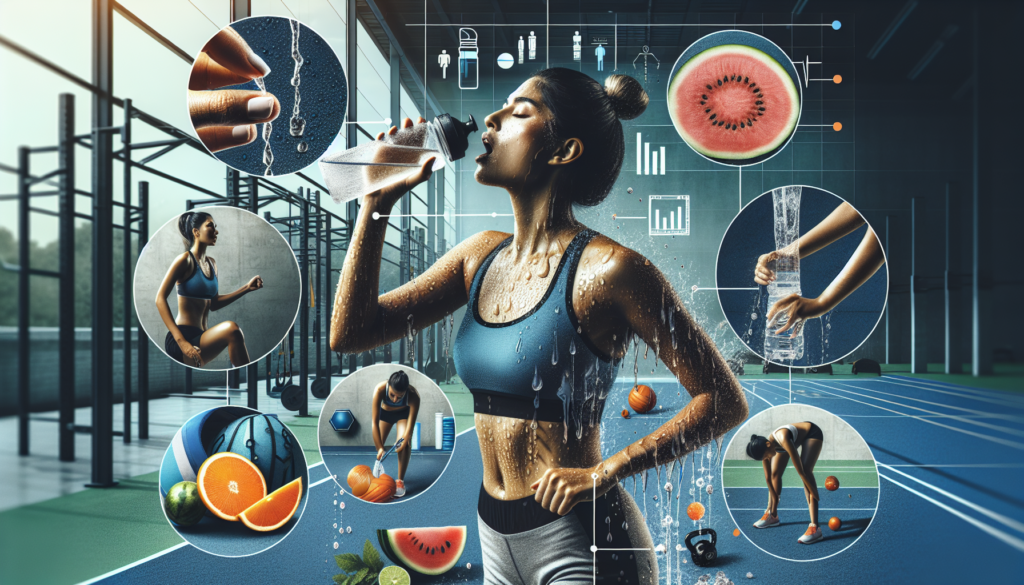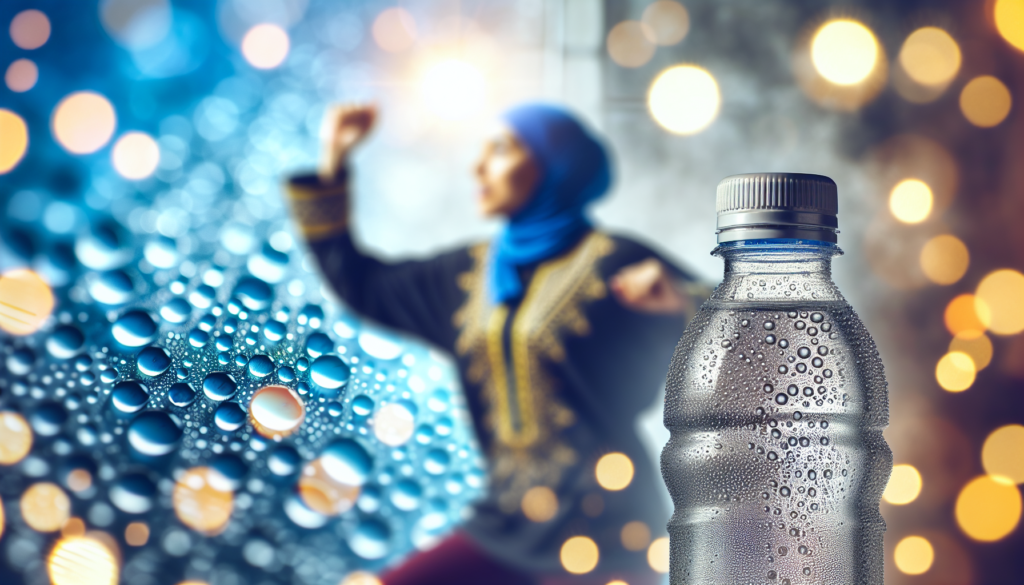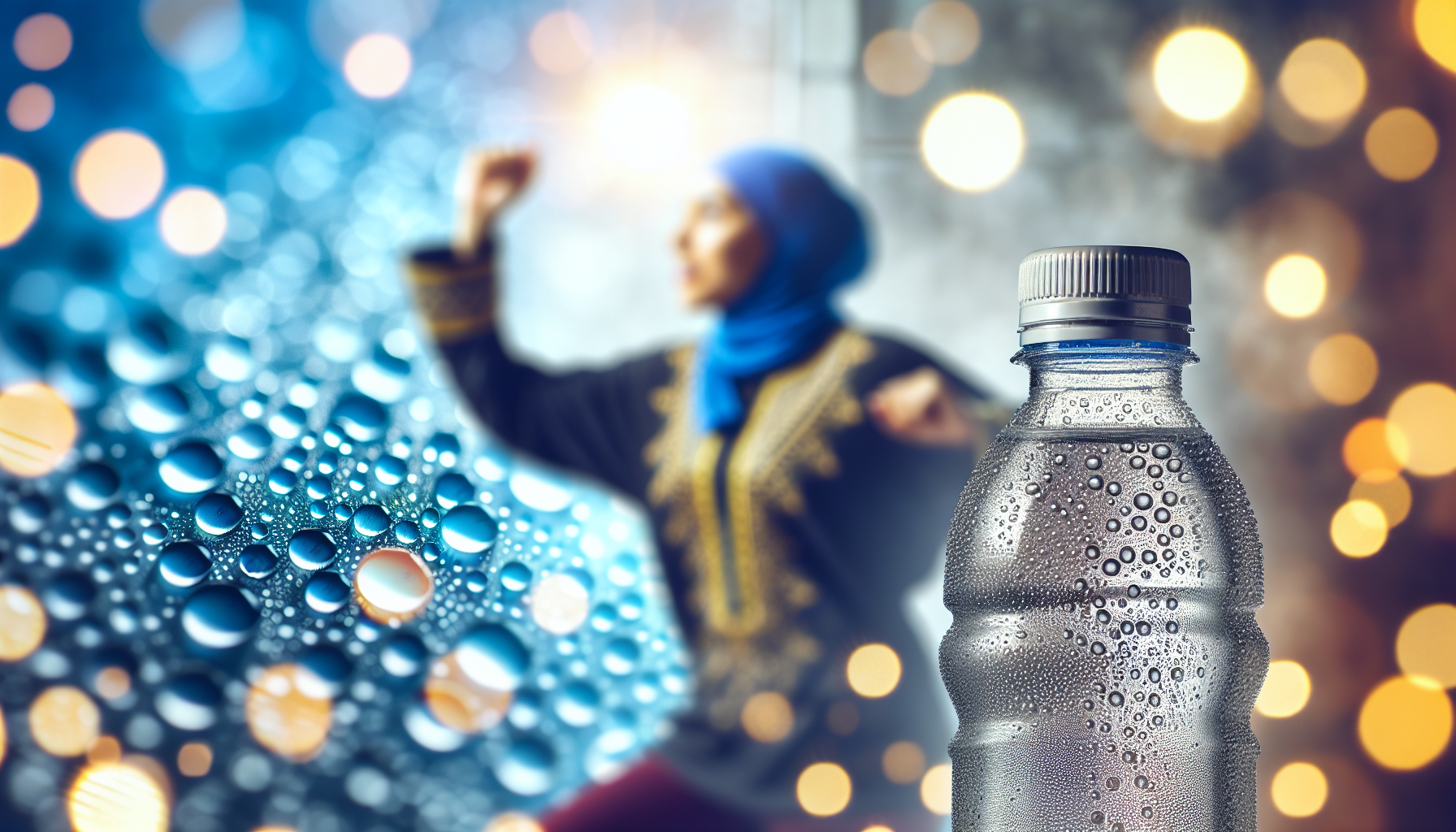So you’ve decided to hit the gym and work up a sweat? That’s great! But before you get carried away with your intense workout, let’s talk about the importance of staying hydrated. We all know that water is essential for our overall health, but when it comes to exercising, it becomes even more crucial. In this article, we’ll explore some of the top ways to stay hydrated during workouts, so you can maximize your performance and avoid any unpleasant dehydration symptoms. Ready to quench your thirst for knowledge? Let’s get started!

Monitor Your Fluid Intake
Calculate your fluid needs
To ensure you stay properly hydrated during workouts, it’s important to calculate your fluid needs. This can vary depending on factors such as your body weight, intensity of exercise, and climate conditions. A general guideline is to aim for about 0.5 to 1 ounce of fluid per pound of body weight per day. However, during intense workouts or hot weather, you may need to increase your fluid intake.
Drink water before, during, and after workouts
Water is a fundamental choice to quench your thirst and keeps you hydrated throughout your workout sessions. Make it a habit to drink water before, during, and after your workouts. It is recommended to drink about 16 to 20 ounces of water two to three hours before exercising. During your workout, sip on water every 15 to 20 minutes to replenish the fluids lost through sweat. After your exercise session, drink another 8 to 16 ounces of water to rehydrate your body.
Use a water bottle or hydration pack
Having a water bottle or hydration pack easily accessible during your workouts is key to maintaining hydration. Choose a bottle that is easy to carry and holds an adequate amount of water for your needs. Consider using a hydration pack, especially for longer workouts or outdoor activities, as they provide a convenient way to carry and access water without having to stop or carry a bulky bottle.
Track your fluid intake
Monitoring your fluid intake can help you ensure you are meeting your hydration goals. Consider using a hydration tracking app or simply keeping a journal to record how much water you are consuming throughout the day. This will help you stay accountable and make adjustments to your fluid intake if needed.
Choose the Right Fluids
Opt for water
Water should be your primary fluid of choice for hydration. It is calorie-free, readily available, and essential for overall health. Drinking plain water helps replenish lost fluids and keeps you hydrated without adding unnecessary sugars or calories.
Consider sports drinks for intense workouts
For intense workouts lasting longer than an hour or taking place in hot and humid conditions, sports drinks can be beneficial. They contain electrolytes, such as sodium and potassium, which help replenish the minerals lost through sweat. Sports drinks also provide carbohydrates for energy during longer exercise sessions.
Include electrolyte-rich beverages
Electrolyte-rich beverages such as coconut water or electrolyte-enhanced water are also alternatives to sports drinks. These beverages provide essential electrolytes and can be a refreshing way to replenish your body’s mineral balance. Just be mindful of any added sugars or artificial additives in these drinks.
Avoid caffeine and alcohol
While these beverages may be enjoyable in moderation, it’s best to avoid them when it comes to hydrating during workouts. Caffeine and alcohol can have diuretic effects, causing your body to urinate more frequently and potentially leading to dehydration. Stick to water, sports drinks, or electrolyte-rich beverages for optimal hydration.
Maintain a Hydration Schedule
Drink water at regular intervals
To maintain hydration, it’s important to drink water at regular intervals throughout the day, not just during your workouts. By sipping water consistently, you ensure that your body remains hydrated, especially in preparation for physical activity. Aim to drink water every couple of hours to keep your fluid intake steady.
Have fluids before, during, and after each workout
Hydrating before, during, and after each workout is crucial for optimal performance and recovery. Make it a habit to drink water or other fluids before you begin exercising. Sip on fluids during your workout to replace what you’re losing through sweat. Finally, rehydrate after your workout to replenish your body and support muscle recovery.
Set reminders for hydrating
In our busy lives, it’s easy to forget to hydrate. Setting reminders or using hydration tracking apps can help you establish a hydration schedule and ensure you’re drinking enough water throughout the day. These reminders can be especially helpful during busy workdays or when you’re engrossed in a challenging workout.
Create a hydration plan
Having a hydration plan in place can help you stay on track with your fluid intake. Consider creating a schedule that outlines when and how much water you should drink throughout the day, both during workouts and at rest. By having a plan, you can be proactive about staying hydrated and make it a priority in your daily routine.
Pay Attention to Your Sweat
Know the signs of dehydration
Understanding the signs of dehydration is crucial for maintaining proper hydration. Symptoms of dehydration can include increased thirst, dry mouth, dizziness, fatigue, and decreased urine output. If you experience any of these signs, it’s essential to rehydrate immediately to prevent further dehydration and potential health issues.
Monitor urine color
Monitoring the color of your urine can provide valuable insights into your hydration status. Aim for a pale yellow color, similar to the color of straw. Darker urine indicates that you may be dehydrated and should increase your fluid intake. If your urine is consistently dark or you experience other symptoms of dehydration, it’s important to consult a healthcare professional.
Weigh yourself pre and post-workout
Tracking your weight before and after workouts can help you estimate how much fluid you’ve lost through sweat. For every pound lost during exercise, you will need to drink about 16 to 24 ounces of water to rehydrate properly. Keep in mind that this method is not foolproof and it’s important to consider other hydration indicators as well.
Understand sweat rate
Understanding your sweat rate can help you tailor your hydration strategy. Weigh yourself before and after a workout session to determine how much weight you’ve lost due to fluid loss. The difference in weight, along with the duration of the workout, can help you estimate your sweat rate. This information can guide your fluid intake during future workouts to prevent dehydration.

Eat Hydrating Foods
Include fruits and vegetables with high water content
Adding fruits and vegetables with high water content to your diet is an excellent way to supplement your fluid intake. Water-rich fruits like watermelon, strawberries, oranges, and grapefruit can provide hydration while also offering valuable vitamins and minerals. Similarly, vegetables like cucumbers, lettuce, zucchini, and celery are hydrating options to consider.
Have watery snacks like watermelon or cucumber
Snacking on watery foods like watermelon or cucumber can also contribute to your overall hydration. These snacks not only offer hydration but also provide a refreshing and flavorful option. Cut up some watermelon or keep cucumber slices handy for a hydrating and delicious treat during your workouts.
Consume soups and broths
Soups and broths are an excellent way to stay hydrated, especially during the colder months. Choose soups that are low in sodium and rich in vegetables for maximum hydration benefits. Warm soups can be comforting during workouts or on recovery days and help replenish fluids lost through sweat.
Add foods rich in electrolytes
Electrolytes are essential for proper hydration and maintaining the body’s fluid balance. Including foods rich in electrolytes, such as bananas, avocados, yogurt, and coconut water, can be beneficial for maintaining hydration levels. These foods are not only hydrating but also offer additional nutrients to support overall health.
Prevent Overhydration
Do not drink excessive water at once
While it’s important to stay adequately hydrated, it’s equally important not to overhydrate. Drinking excessive amounts of water at once can lead to a condition known as hyponatremia, where the sodium levels in your blood become diluted. This can be dangerous and potentially life-threatening. Sip water gradually throughout the day instead of chugging large amounts all at once.
Understand the dangers of overhydration
Overhydration can lead to an imbalance of electrolytes in the body and hyponatremia. Symptoms of overhydration can include nausea, headache, confusion, and in severe cases, seizures or coma. It’s important to be mindful of your fluid intake and listen to your body’s thirst cues to avoid overhydration.
Listen to your body’s thirst cues
Your body’s thirst cues are a valuable indicator of when you need to hydrate. Pay attention to feelings of thirst and drink water or other hydrating fluids when you feel the need. Thirst is a natural response that indicates your body requires fluids, so it’s important not to ignore these signals.
Consult a healthcare professional if unsure
If you’re unsure about your fluid intake or have concerns about hydration, it’s always best to consult a healthcare professional. They can provide personalized guidance based on your specific needs and help you establish a safe and effective hydration plan. Don’t hesitate to reach out to a healthcare professional for expert advice and support.
Manage Environmental Factors
Stay hydrated in hot and humid conditions
Hot and humid conditions can increase fluid loss through sweat, making it crucial to stay hydrated. In such conditions, it’s important to increase your fluid intake and make an effort to drink water or other hydrating fluids more frequently. Be proactive in monitoring your hydration levels and adjust your intake accordingly.
Account for altitude and dry climates
Altitude and dry climates can also contribute to increased fluid loss and dehydration. When exercising at higher altitudes or in dry climates, your body may lose more fluids through respiration and sweat. Therefore, it’s important to compensate by increasing your fluid intake and paying extra attention to your hydration needs.
Wear appropriate workout attire
Wearing appropriate workout attire can help regulate body temperature and minimize excessive sweat. Choose lightweight and breathable fabrics that wick away moisture and allow airflow. This will help prevent overheating and excessive fluid loss during your workouts.
Take breaks in shaded areas
When exercising outdoors, especially in hot weather, it’s important to take breaks in shaded areas to cool down and avoid excessive sun exposure. This can help prevent overheating and reduce sweat rate. Taking these breaks also allows you to hydrate and rest, ensuring you can maintain your exercise routine safely and comfortably.
Use Hydration Aids
Try electrolyte tablets or powders
Electrolyte tablets or powders can be a convenient way to replenish electrolytes during workouts. These products are designed to dissolve in water, adding essential electrolytes without any added sugars or calories. They are portable and easy to use, making them a practical option for staying hydrated on the go.
Use a hydration bladder
A hydration bladder is a hydration system that consists of a reservoir and a tube with a bite valve. It allows you to carry a larger volume of water on your back, making it convenient for activities like hiking, cycling, or running. The tube and bite valve provide easy access to water without interrupting your workout.
Consider freeze sleeves or cooling towels
Freeze sleeves or cooling towels are useful aids for staying cool and hydrated during workouts. These products can be soaked in water, wrung out, and worn around your neck or on your wrists. They provide a refreshing sensation and help lower body temperature, ensuring you stay comfortable and hydrated during intense workouts.
Use popsicles or frozen fruits
Popsicles or frozen fruits can be a fun and refreshing way to hydrate during workouts, especially in warm weather. Make your own popsicles using natural fruit juices or freeze bite-sized pieces of fruits like grapes, berries, or melons. These frozen treats not only provide hydration but also offer a tasty and nutritious option during your workouts.
Hydrate Before Different Types of Workouts
Hydration for cardio exercises
For cardio exercises like running, cycling, or aerobics, hydrating before, during, and after your workouts is essential. Cardio workouts generally involve higher intensities and longer durations, leading to increased fluid loss through sweat. Make sure to drink water or other hydrating fluids regularly to maintain optimal hydration levels.
Hydration for weightlifting and strength training
Although weightlifting and strength training may not involve as much sweat as cardio exercises, proper hydration is still crucial. Stay hydrated before your workout, and sip on water or other fluids during rest periods between sets. After your workout, rehydrate to support muscle recovery and replenish fluids lost during exercise.
Hydration for endurance sports
Endurance sports such as long-distance running, triathlons, or cycling events require special attention to hydration. Hydrate well in advance of your event, ensuring you’re adequately hydrated before you start. During the event, follow a hydration plan that includes sipping on fluids at regular intervals. Hydration aids like hydration bladders or electrolyte tablets can be beneficial during endurance sports.
Hydration for high-intensity interval training (HIIT)
Hydrating for high-intensity interval training (HIIT) workouts is similar to cardio exercises. Since HIIT workouts are intense and often involve short bursts of high-intensity exercise, you’ll want to ensure you’re properly hydrated before, during, and after your workouts. Drink water or other hydrating fluids as needed to maintain optimal performance and prevent dehydration.
Listen to Your Body
Stay aware of signs of dehydration
Staying aware of the signs of dehydration is crucial for maintaining proper hydration. Be mindful of increased thirst, dry mouth, dizziness, fatigue, or decreased urine output. If you experience any of these symptoms, it’s important to rehydrate immediately to prevent further dehydration and potential health complications.
Adjust your fluid intake based on sweat and exertion levels
Your fluid intake may need adjustments based on the intensity of your workouts and the amount you’re sweating. If you’re engaging in a particularly intense workout or notice excessive sweat, it’s essential to drink more fluids to compensate for the increased fluid loss. Similarly, on lighter workout days, you may not need as much fluid and can adjust your intake accordingly.
Don’t ignore thirst signals
Thirst is your body’s way of signaling that you need to hydrate. Ignoring thirst signals can lead to dehydration and performance decline. It’s important to listen to your body and drink water or other hydrating fluids when you feel thirsty. By responding to your thirst cues, you can maintain optimal hydration and support your overall well-being.
Modify hydrating techniques as needed
Everyone’s hydration needs can be slightly different, depending on factors like body composition, exercise intensity, and climate conditions. It’s essential to be flexible and modify your hydrating techniques as needed. Pay attention to how your body responds to different hydration strategies and make adjustments to ensure you’re meeting your individual needs.
Staying hydrated during workouts is vital for maintaining performance, supporting recovery, and promoting overall health. By monitoring your fluid intake, choosing the right fluids, maintaining a hydration schedule, paying attention to your sweat, eating hydrating foods, preventing overhydration, managing environmental factors, using hydration aids, hydrating before different types of workouts, and listening to your body, you can ensure you stay well-hydrated and optimize your workout experience. Remember, hydration is a key component of your fitness journey, so make it a priority and reap the benefits of a well-hydrated body.
